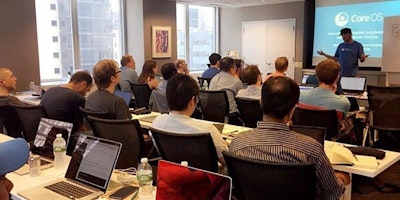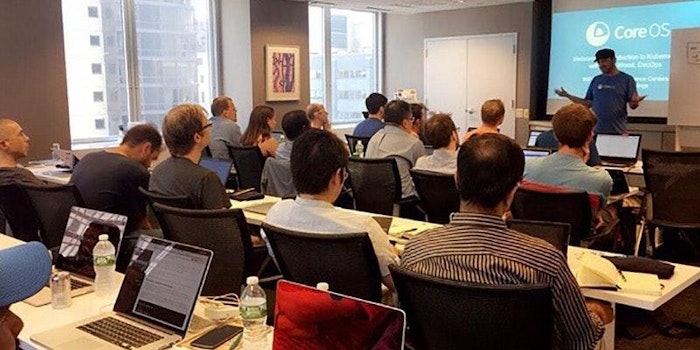
September Kubernetes Training - Los Angeles
Friday, September 1, 2017
MicroTek - Los Angeles (El Segundo, CA), EL SEGUNDO, United States

September Kubernetes Training - Los Angeles
Friday, September 1, 2017
MicroTek - Los Angeles (El Segundo, CA), EL SEGUNDO, United States
What you need to know
Quickly get up to speed on Kubernetes by leveraging the expertise of CoreOS, the team that created the building blocks for modern distributed systems. During this hands on course you will learn how to deploy and manage applications using the power of Kubernetes. At the same time, you will learn how to effectively operate and maintain a Kubernetes cluster. You will be exposed to critical Kubernetes concepts and have the opportunity to learn best practices designed to ensure your success with this technology.
Prerequisites:
Comfort with the Linux command line and a working knowledge of networking, cloud, and virtualization concepts.
Course details:
2 days
Hours: 9:00am - 4:00pm
Lunches provided, vegetarian option available
Topics Covered**:
Kubernetes Quick Start
Container creation
Image repositories
Kubectl primer
Basic application deployments
Deployments Exposed
Deployments
Pods and Containers
Services
Running your App
Anatomy of the App
Dry runs
Using environment variables
Switching container commands
Custom arguments
Image pull policies
Application restarts
Application Scaling
ReplicaSets
Scaling and the Pod
Failure scenarios
Designing for Scale
Autoscaling
Updating an Application
Refreshing an Image
Setting a new deployment image
Deployment rollouts
Deployment rollbacks
Pausing a deployment
The deployment lifecycle
Configuration Files and Specs
Anatomy of the Config File
Deployment Specs
Service Specs
Multi-Container Deployments
Dealing with Storage
Empty Dir
Secret volumes
Host Path
Git Repo
Downward API
Persistent volumes
Application Configuration
ConfigMap overview
Configuration directories
Configuration files
Configuration through environment variables
Configuration on the command line
Configuration volumes
Secrets
Jobs and Daemons
Running jobs in the cluster
Job specs
Reviewing job output
Running Daemons in the cluster
DaemonSets
Stateful Applications
StatefulSets Explained
StatefulSet Spec
Services and StatefulSets
Storage and the StatefulSet
Hostnames and StatefulSets
Ingress
Ingress Controllers Explained
Ingress Controller Comparison
Deploying Ingress Controllers
Creating Ingress Resource Objects
Namespaces
Default
System
Creating and accessing
Architecture Overview
Cluster Control Plane
Nodes
Etcd
Cluster Control Plane
API Server
Controller Manager
Scheduler
Worker Nodes
Kubelet
Container Runtime
Kube Proxy
Add Ons
DNS
Ingress
Heapster
Dashboard
Networking
Kubernetes Networking Model
Container to Container
Pod to Pod
Pod to Service
External to Internal
Networking Plugins (plugins)
Updates - In Place, Disruptive or Nondisruptive
Apply
Edit
Patch
Replace
Bulk Operations
Composite Specs
Labels
Annotations
Selectors
Canary Deployments
Canaries Explained
Labeling strategy
Deploying a canary
Resource Allocation and Quotas
Resource Requests
Resource Limits
Scheduling
Compute Quotas
Storage Quotas
Object Count Quotas
Pod Placement
Scheduling
Node Selector
Affinity and Anti-Affinity
Taints and Tolerations
Node Management
Drain
Cordon
Authentication
Service Accounts
Users
Auth Strategies
Anonymous Requests
Impersonation
Authorization
RBAC
Roles and ClusterRoles
RoleBindings and ClusterRoleBindings
ABAC and Webook authorization modules
Logging and Monitoring
Kubernetes Logs
Application Level Monitoring
Node Level Monitoring
Cluster Level Monitoring
Federation
About Kubernetes Federation and kubefed
Deploying a Federation Control Plane
Adding clusters
Removing clusters
** Topics covered are subject to change based upon the needs of the class and changes in the technology.
Prerequisites:
Comfort with the Linux command line and a working knowledge of networking, cloud, and virtualization concepts.
Course details:
2 days
Hours: 9:00am - 4:00pm
Lunches provided, vegetarian option available
Topics Covered**:
Kubernetes Quick Start
Container creation
Image repositories
Kubectl primer
Basic application deployments
Deployments Exposed
Deployments
Pods and Containers
Services
Running your App
Anatomy of the App
Dry runs
Using environment variables
Switching container commands
Custom arguments
Image pull policies
Application restarts
Application Scaling
ReplicaSets
Scaling and the Pod
Failure scenarios
Designing for Scale
Autoscaling
Updating an Application
Refreshing an Image
Setting a new deployment image
Deployment rollouts
Deployment rollbacks
Pausing a deployment
The deployment lifecycle
Configuration Files and Specs
Anatomy of the Config File
Deployment Specs
Service Specs
Multi-Container Deployments
Dealing with Storage
Empty Dir
Secret volumes
Host Path
Git Repo
Downward API
Persistent volumes
Application Configuration
ConfigMap overview
Configuration directories
Configuration files
Configuration through environment variables
Configuration on the command line
Configuration volumes
Secrets
Jobs and Daemons
Running jobs in the cluster
Job specs
Reviewing job output
Running Daemons in the cluster
DaemonSets
Stateful Applications
StatefulSets Explained
StatefulSet Spec
Services and StatefulSets
Storage and the StatefulSet
Hostnames and StatefulSets
Ingress
Ingress Controllers Explained
Ingress Controller Comparison
Deploying Ingress Controllers
Creating Ingress Resource Objects
Namespaces
Default
System
Creating and accessing
Architecture Overview
Cluster Control Plane
Nodes
Etcd
Cluster Control Plane
API Server
Controller Manager
Scheduler
Worker Nodes
Kubelet
Container Runtime
Kube Proxy
Add Ons
DNS
Ingress
Heapster
Dashboard
Networking
Kubernetes Networking Model
Container to Container
Pod to Pod
Pod to Service
External to Internal
Networking Plugins (plugins)
Updates - In Place, Disruptive or Nondisruptive
Apply
Edit
Patch
Replace
Bulk Operations
Composite Specs
Labels
Annotations
Selectors
Canary Deployments
Canaries Explained
Labeling strategy
Deploying a canary
Resource Allocation and Quotas
Resource Requests
Resource Limits
Scheduling
Compute Quotas
Storage Quotas
Object Count Quotas
Pod Placement
Scheduling
Node Selector
Affinity and Anti-Affinity
Taints and Tolerations
Node Management
Drain
Cordon
Authentication
Service Accounts
Users
Auth Strategies
Anonymous Requests
Impersonation
Authorization
RBAC
Roles and ClusterRoles
RoleBindings and ClusterRoleBindings
ABAC and Webook authorization modules
Logging and Monitoring
Kubernetes Logs
Application Level Monitoring
Node Level Monitoring
Cluster Level Monitoring
Federation
About Kubernetes Federation and kubefed
Deploying a Federation Control Plane
Adding clusters
Removing clusters
** Topics covered are subject to change based upon the needs of the class and changes in the technology.
Location
MicroTek - Los Angeles (El Segundo, CA)
222 N Sepulveda Blvd Suite 1240, EL SEGUNDO, CA, 90046 United States
When
- Friday, September 1, 2017
- Add to calendar
Organiser
- September Kubernetes Training - Los Angeles
- See more from September Kubernetes Training - Los Angeles
- Terms and privacy policy
